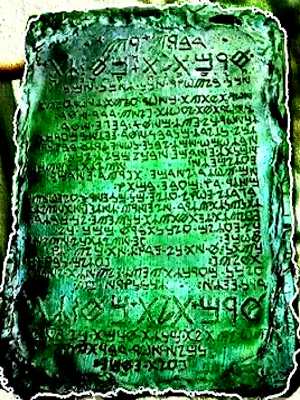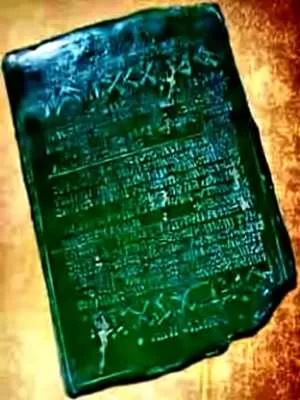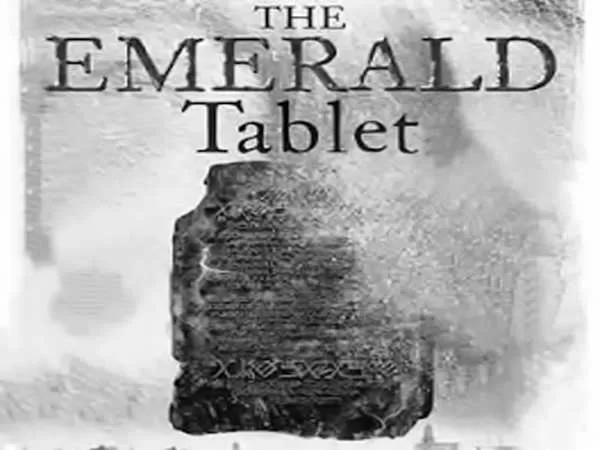The Emerald Tablet is one of the most fascinating and mysterious texts in the history of alchemy and esoteric traditions. Attributed to Hermes Trismegistus, a mythical figure who blended the Greek god Hermes with the Egyptian god Thoth, the Emerald Tablet is said to contain the secret of the philosopher’s stone—the key to transforming base metals into gold and achieving immortality.
Despite its brevity—often summarized as a short, cryptic poem—the Emerald Tablet has had an immense influence on Western esotericism, inspiring alchemists, mystics, and philosophers for centuries. Its enigmatic verses have been interpreted as a guide to both material and spiritual transformation, offering insights into the mysteries of the universe.
In this article, we explore the history, content, and impact of the Emerald Tablet, tracing its roots in ancient Egyptian and Greek thought while also examining its role in the development of alchemy and its enduring legacy in modern esoteric traditions.
Origins of the Emerald Tablet

The origins of the Emerald Tablet are shrouded in mystery. According to legend, the tablet was discovered in a cave, either in Egypt or Arabia, engraved on an emerald or green stone. It is often attributed to Hermes Trismegistus, a syncretic figure who represents the union of Greek and Egyptian knowledge. Hermes Trismegistus is said to have written the tablet to record the most profound secrets of alchemy, magic, and the cosmos.
Scholars believe the tablet was likely composed sometime between the 6th and 8th centuries, during the early Islamic Golden Age, when Arab scholars translated and preserved ancient Greek and Egyptian texts. It is believed that the text of the Emerald Tablet was translated into Latin in the 12th century and became widely known in Europe, where it was revered as a key to the secrets of alchemy.
Though the historical Hermes Trismegistus may never have existed, his name became a symbol of ancient wisdom and the blending of mystical traditions. The Emerald Tablet was one of many texts attributed to him, and its esoteric teachings were seen as the foundation of alchemical philosophy.
Content of the Emerald Tablet

The most famous version of the Emerald Tablet is a short, cryptic poem composed of 13 lines. It begins with the phrase “As above, so below,” which is often interpreted as a reference to the interconnectedness of the macrocosm (the universe) and the microcosm (the individual human being). This idea is central to the teachings of alchemy, suggesting that by understanding the workings of the cosmos, one can also understand the processes of personal and spiritual transformation.
The tablet goes on to describe the process of alchemical transmutation, explaining how the philosopher’s stone can be created by purifying and refining the elements. While the specific details of this process are left vague, the text is often interpreted as a metaphor for the transformation of the soul, with the base metals representing the imperfections of human nature and the philosopher’s stone symbolizing enlightenment or divine wisdom.
The full translation of the Emerald Tablet includes lines that touch on the relationship between spirit and matter, the unity of the elements, and the cycles of life and death. Its verses have been analyzed and interpreted by countless scholars, philosophers, and mystics over the centuries, with each generation finding new layers of meaning in its enigmatic words.
Influence of the Emerald Tablet on Alchemy
The Emerald Tablet is often considered the cornerstone of Western alchemy. Its teachings on transformation, purification, and unity became central to the alchemical tradition, which sought to unlock the secrets of nature and achieve mastery over both the material and spiritual realms.
Alchemists throughout the Middle Ages and the Renaissance studied the Emerald Tablet as a guide to their work. They believed that the text held the key to the philosopher’s stone, a legendary substance that could turn base metals into gold and grant immortality. However, many alchemists also understood the tablet as a metaphor for spiritual transformation, viewing the philosopher’s stone as a symbol of enlightenment and the perfection of the soul.
The phrase “As above, so below” became a fundamental principle of alchemical thought, representing the idea that the processes of the heavens are mirrored on Earth and within the human body. This principle was reflected in alchemical practices that sought to harmonize the elements of the physical world with the divine forces of the cosmos.
The Emerald Tablet also influenced other esoteric traditions, including astrology, Hermeticism, and Kabbalah. Its teachings on the unity of the elements and the interrelationship of spirit and matter were incorporated into a wide range of mystical practices and philosophies, all of which sought to understand the hidden workings of the universe.
Interpretations and Mystical Meanings
Over the centuries, the Emerald Tablet has been interpreted in many different ways, reflecting the evolving understanding of alchemy and mysticism. While early alchemists focused on its teachings as a guide to physical transmutation, later scholars emphasized its symbolic meaning as a metaphor for spiritual enlightenment.

One of the most famous interpreters of the Emerald Tablet was the 16th-century Swiss alchemist Paracelsus, who saw the text as a guide to both physical and spiritual healing. Paracelsus believed that the philosopher’s stone represented a perfect balance of the elements, which could be achieved through both chemical processes and the cultivation of inner wisdom.
In the 17th century, the Emerald Tablet was embraced by Rosicrucian and Hermetic traditions, which saw it as a key to unlocking the mysteries of the universe. These groups believed that the tablet contained secret knowledge that had been passed down from the ancient Egyptian priests and that its teachings could lead to a deeper understanding of the divine.
In modern times, the Emerald Tablet continues to be studied by practitioners of alchemy, Hermeticism, and other esoteric traditions. It is often seen as a symbol of the unity of science and spirituality, reflecting the idea that the physical and metaphysical worlds are interconnected and that understanding one can lead to mastery over the other.
Search for the Philosopher’s Stone
The quest for the philosopher’s stone has been one of the most enduring mysteries of alchemy, and the Emerald Tablet has often been seen as the key to unlocking its secrets. For centuries, alchemists sought to create this elusive substance, which was believed to have the power to transmute base metals into gold, cure diseases, and grant immortality.
While many alchemists focused on the material aspects of the philosopher’s stone, others viewed it as a symbol of spiritual transformation. In this interpretation, the philosopher’s stone represents the perfection of the soul, achieved through a process of purification and enlightenment.
The teachings of the Emerald Tablet have inspired countless alchemical experiments and spiritual practices aimed at achieving this goal. Although the philosopher’s stone has never been found, its symbolism continues to resonate with those who seek to understand the deeper mysteries of existence.
Legacy of the Emerald Tablet
The Emerald Tablet has had a profound impact on Western esotericism, influencing not only alchemy but also a wide range of mystical and philosophical traditions. Its teachings on the unity of spirit and matter, the interconnectedness of the cosmos, and the transformative power of knowledge have inspired generations of thinkers and seekers.
In addition to its role in alchemy, the Emerald Tablet has also been embraced by modern spiritual movements, including New Age philosophy and alternative healing practices. Its message of balance, harmony, and transformation continues to resonate with those who seek to understand the relationship between the material and spiritual worlds.
The enduring appeal of the Emerald Tablet lies in its ability to speak to both the mind and the soul. Its cryptic verses invite deep contemplation and personal interpretation, offering insights into the nature of reality and the potential for human transformation. Whether viewed as a guide to alchemical practice or as a symbol of spiritual enlightenment, the Emerald Tablet remains one of the most powerful and intriguing texts in the history of esotericism.
Conclusion
The Emerald Tablet stands as a timeless symbol of the quest for knowledge, transformation, and unity. Its teachings have shaped the development of alchemy and Western esotericism, offering a path to both material and spiritual mastery. While its origins and true meaning may remain shrouded in mystery, the Emerald Tablet continues to inspire those who seek to unlock the secrets of the universe and achieve a deeper understanding of themselves and the cosmos.

